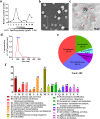Probiotic Escherichia coli Nissle 1917-derived outer membrane vesicles enhance immunomodulation and antimicrobial activity in RAW264.7 macrophages
- PMID: 32854612
- PMCID: PMC7457259
- DOI: 10.1186/s12866-020-01953-x
Probiotic Escherichia coli Nissle 1917-derived outer membrane vesicles enhance immunomodulation and antimicrobial activity in RAW264.7 macrophages
Abstract
Background: Probiotic Escherichia coli Nissle 1917 (EcN) has been widely studied for the treatment of intestinal inflammatory diseases and infectious diarrhea, but the mechanisms by which they communicate with the host are not well-known. Outer membrane vesicles (OMVs) are produced by Gram-negative bacteria and deliver microbial molecules to distant target cells in the host, which play a very important role in mediating bacteria-host communication. Here, we aimed to investigate whether EcN-derived OMVs (EcN_OMVs) could mediate immune regulation in macrophages.
Results: In this study, after the characterization of EcN_OMVs using electron microscopy, nanoparticle tracking and proteomic analyses, we demonstrated by confocal fluorescence microscopy that EcN_OMVs could be internalized by RAW 264.7 macrophages. Stimulation with EcN_OMVs at appropriate concentrations promoted proliferation, immune-related enzymatic activities and phagocytic functions of RAW264.7 cells. Moreover, EcN_OMVs induced more anti-inflammatory responses (IL-10) than pro-inflammatory responses (IL-6 and TNF-α) in vitro, and also modulated the production of Th1-polarizing cytokine (IL-12) and Th2-polarizing cytokine (IL-4). Treatments with EcN_OMVs effectively improved the antibacterial activity of RAW 264.7 macrophages.
Conclusions: These findings indicated that EcN_OMVs could modulate the functions of the host immune cells, which will enrich the existing body of knowledge of EVs as an important mechanism for the communication of probiotics with their hosts.
Keywords: Escherichia coli Nissle 1917; Extracellular vesicle; Macrophages; Microbiota-host communication; Outer membrane vesicles; Probiotics.
Conflict of interest statement
We declare that we have no competing interests.
Figures






Similar articles
-
Outer membrane vesicles derived from probiotic Escherichia coli Nissle 1917 promote metabolic remodeling and M1 polarization of RAW264.7 macrophages.Front Immunol. 2025 May 29;16:1501174. doi: 10.3389/fimmu.2025.1501174. eCollection 2025. Front Immunol. 2025. PMID: 40510339 Free PMC article.
-
Proteomic analysis of outer membrane vesicles from the probiotic strain Escherichia coli Nissle 1917.Proteomics. 2014 Feb;14(2-3):222-9. doi: 10.1002/pmic.201300328. Epub 2014 Jan 6. Proteomics. 2014. PMID: 24307187
-
Efficient Isolation of Outer Membrane Vesicles (OMVs) Secreted by Gram-Negative Bacteria via a Novel Gradient Filtration Method.Membranes (Basel). 2024 Jun 6;14(6):135. doi: 10.3390/membranes14060135. Membranes (Basel). 2024. PMID: 38921502 Free PMC article.
-
Intestinal effect of the probiotic Escherichia coli strain Nissle 1917 and its OMV.J Diabetes Metab Disord. 2020 May 1;19(1):597-604. doi: 10.1007/s40200-020-00511-6. eCollection 2020 Jun. J Diabetes Metab Disord. 2020. PMID: 32550212 Free PMC article. Review.
-
Genetic engineering of probiotic Escherichia coli Nissle 1917 for clinical application.Appl Microbiol Biotechnol. 2016 Oct;100(20):8693-9. doi: 10.1007/s00253-016-7829-5. Epub 2016 Sep 17. Appl Microbiol Biotechnol. 2016. PMID: 27640192 Review.
Cited by
-
Membrane Vesicles Derived from Gut Microbiota and Probiotics: Cutting-Edge Therapeutic Approaches for Multidrug-Resistant Superbugs Linked to Neurological Anomalies.Pharmaceutics. 2022 Nov 3;14(11):2370. doi: 10.3390/pharmaceutics14112370. Pharmaceutics. 2022. PMID: 36365188 Free PMC article. Review.
-
The activation impact of lactobacillus-derived extracellular vesicles on lipopolysaccharide-induced microglial cell.BMC Microbiol. 2024 Feb 28;24(1):70. doi: 10.1186/s12866-024-03217-4. BMC Microbiol. 2024. PMID: 38418961 Free PMC article.
-
Engineering probiotic-derived outer membrane vesicles as functional vaccine carriers to enhance immunity against SARS-CoV-2.iScience. 2023 Jan 20;26(1):105772. doi: 10.1016/j.isci.2022.105772. Epub 2022 Dec 8. iScience. 2023. PMID: 36510593 Free PMC article.
-
Supplementation of Labneh with Passion Fruit Peel Enhanced Survival of E. coli Nissle 1917 during Simulated Gastrointestinal Digestion and Adhesion to Caco-2 Cells.Foods. 2022 Jun 6;11(11):1663. doi: 10.3390/foods11111663. Foods. 2022. PMID: 35681414 Free PMC article.
-
The seven constitutive respiratory defense barriers against SARS-CoV-2 infection.Rev Soc Bras Med Trop. 2021 Dec 17;54:e04612021. doi: 10.1590/0037-8682-0461-2021. eCollection 2021. Rev Soc Bras Med Trop. 2021. PMID: 34932765 Free PMC article. Review.
References
-
- Sanders ME, Merenstein DJ, Reid G, Gibson GR, Rastall RA. Probiotics and prebiotics in intestinal health and disease: from biology to the clinic. Nat Rev Gastro Hepat. 2019;16:605–616. - PubMed
-
- Jacobi CA, Malfertheiner P. Escherichia coli Nissle 1917 (Mutaflor): new insights into an old probiotic bacterium. Digest Dis. 2011;29:600–607. - PubMed
-
- Lee E-S, Song E-J, Nam Y-D, Lee S-Y. Probiotics in human health and disease: from nutribiotics to pharmabiotics. J Microbiol. 2018;56:773–782. - PubMed
-
- Shanahan F. Molecular mechanisms of probiotic action: it's all in the strains! Gut. 2011;60:1026–1027. - PubMed
Publication types
MeSH terms
Substances
Grants and funding
LinkOut - more resources
Full Text Sources

